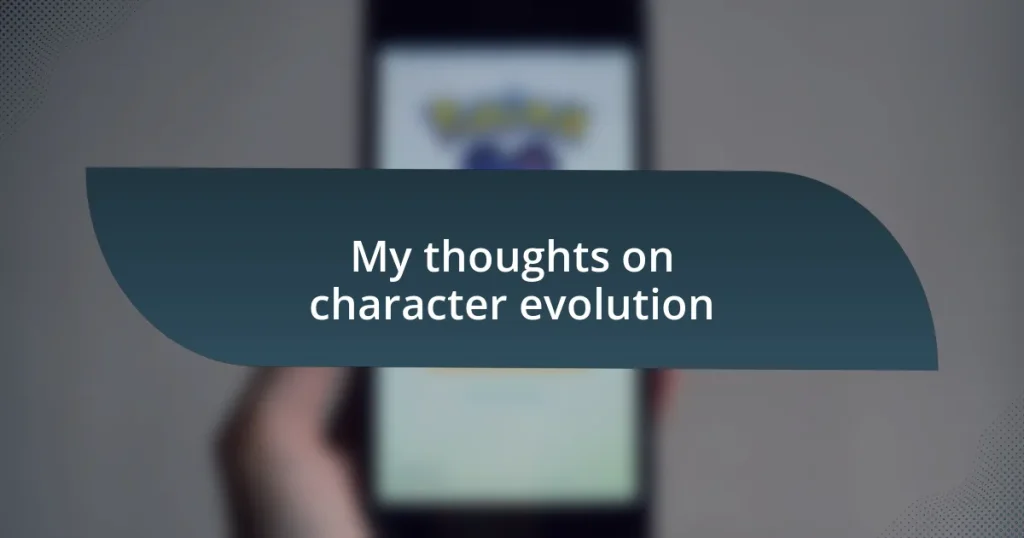Key takeaways:
- Character evolution is driven by conflict, relationships, reflection, motivation, and consequences, enhancing depth and relatability.
- Stages of character development include the “ordinary world,” conflict, and synthesis, illustrating the journey from comfort to growth.
- Relatable character arcs resonate emotionally with readers, fostering connections through shared struggles and moments of vulnerability.
- Techniques for effective character growth include creating transformative arcs, internal conflicts, and strong relationships that catalyze change.
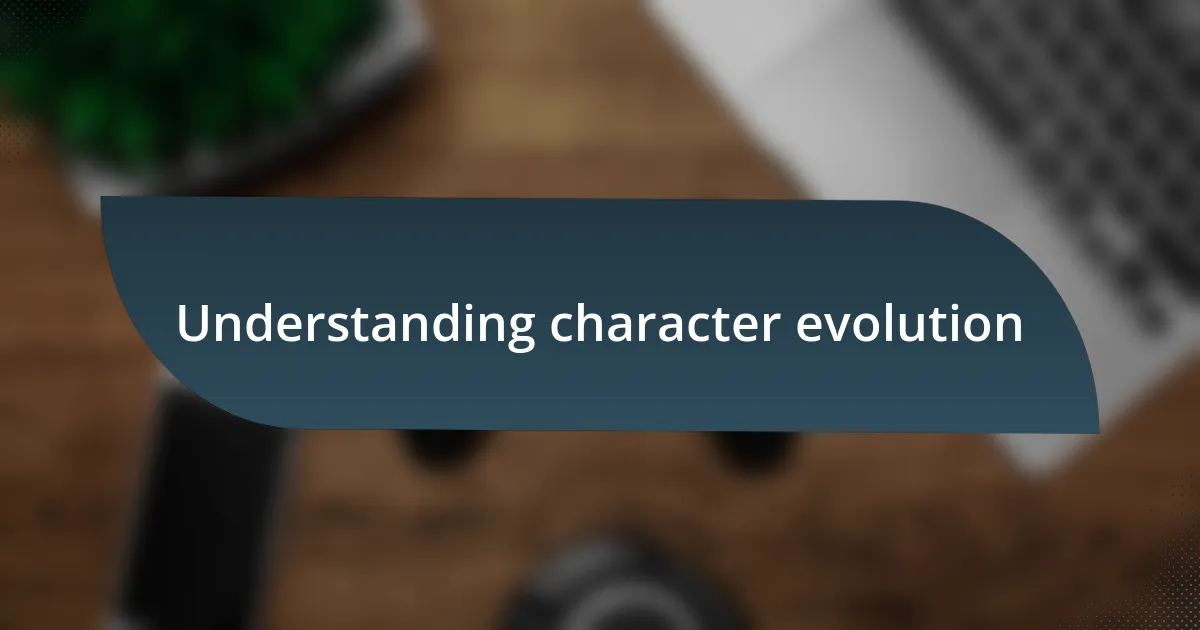
Understanding character evolution
Understanding character evolution is a fascinating journey that keeps me constantly intrigued. Characters are not static; they grow, change, and sometimes regress based on their experiences. Have you ever noticed how a pivotal moment in a story can turn a seemingly one-dimensional character into a complex individual?
I recall a novel where a character faced a moral dilemma that forced them to confront their own values. It was not just about the choice they made, but how that choice reshaped their identity. This transformation was so impactful that I found myself reflecting on my own beliefs and decisions. Isn’t it interesting how character evolution can mirror our personal growth?
Characters, like real people, navigate through challenges that impact their psyche and behavior. I often wonder if we, as readers, sometimes project our struggles onto these characters, finding solace in their journeys. This connection is powerful, as it allows us to experience their growth alongside them, deepening our understanding of human nature.
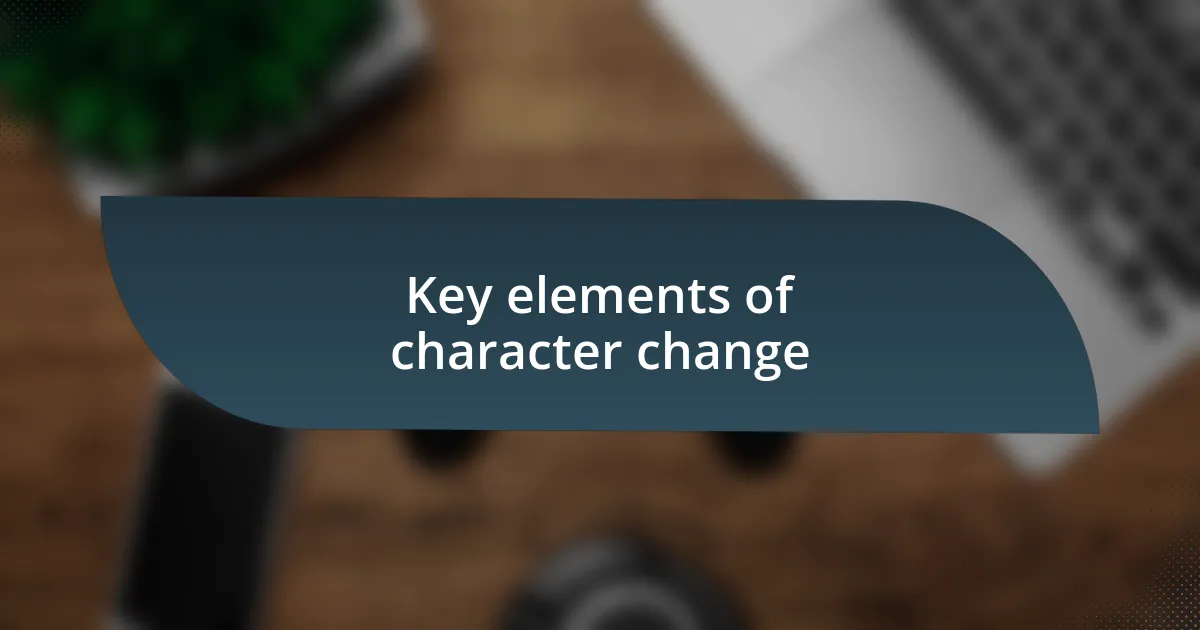
Key elements of character change
Character change is often driven by several key elements that influence a character’s journey. From my perspective, conflict stands out as a catalyst for transformation. Without external or internal struggles, characters tend to remain static, lacking depth. I remember reading a series where the protagonist faced repeated failures. Each setback chipped away at their bravado, revealing insecurities I hadn’t noticed before. This breakdown made their eventual triumph feel all the more rewarding.
Another essential element is the character’s relationships. The interactions a character has, whether positive or negative, can significantly shape their evolution. I’ve observed how friendships can ignite courage, while betrayals can instill distrust. Here are some key components that I believe foster character change:
- Conflict: Challenges faced by the character that force them to adapt.
- Relationships: The influence of others on the character’s decisions and growth.
- Reflection: Moments where characters contemplate their experiences, leading to insights.
- Motivation: What drives a character to change, be it love, fear, or ambition.
- Consequences: The impact of past actions that push a character to evolve.
Recognizing these elements can deepen our understanding of not just the characters, but also the narratives they inhabit.
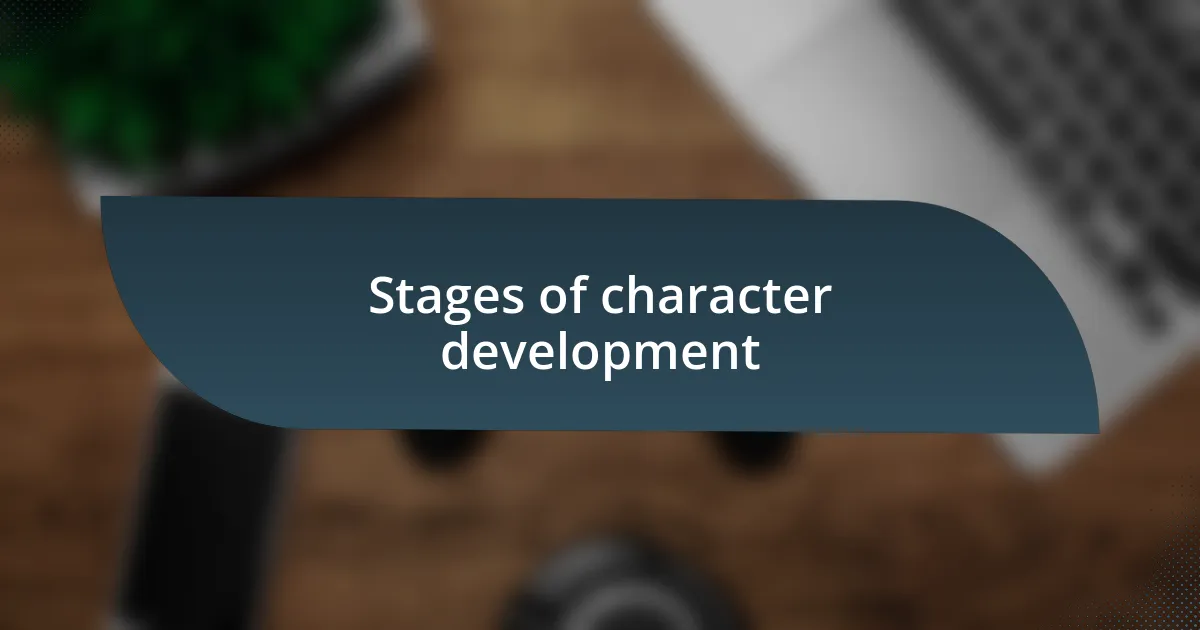
Stages of character development
Character development typically unfolds in several stages, allowing readers to witness a transformation over time. Personally, I find the initial stage, often called the “ordinary world,” particularly intriguing. It’s where we meet the characters in their comfort zones, and we can relate to their everyday lives. A memorable experience for me was when I watched a character go from blissfully unaware of the challenges ahead to stepping into uncertainty, which hooked me right away.
As the narrative progresses, characters encounter pivotal challenges that push them out of their comfort zones. During this stage, conflict becomes the fuel that ignites their growth. I recall a book where the main character started to confront their fears after facing significant adversity. This stage is critical because it reveals a character’s flaws and strengths, making their journey feel authentic.
Eventually, we reach the stage of synthesis, where characters integrate their experiences and evolve. I vividly remember rooting for a character who, after countless trials, learned to embrace their vulnerability. This stage resonates deeply, as it reflects the human desire for growth through adversity. Ultimately, this journey paints a beautiful picture of resilience and transformation.
| Stage | Description |
|---|---|
| Ordinary World | Introduction of the character in their familiar environment, establishing their initial state. |
| Conflict | Challenges arise, forcing the character to confront fears, flaws, and make critical decisions. |
| Synthesis | The character integrates their experiences, leading to growth and newfound understanding. |

Crafting relatable character arcs
Crafting relatable character arcs is all about connecting the character’s journey to the reader’s own experiences. When I think about characters I’ve truly connected with, it’s often those who show vulnerability. For instance, I once read about a character grappling with self-doubt while navigating life choices. This not only made the journey relatable but also stirred my own reflections on the times I’ve felt the same uncertainty in my decisions.
As I consider how to portray growth, I realize that the hurdles characters face should resonate emotionally. I remember a story where the protagonist, after losing a loved one, began to question everything they once believed. This moment struck a chord with me; grief is universal, and it highlighted how pivotal life experiences can shape a person. Aren’t we all transformed by our trials, just as characters are in stories?
Ultimately, characters that evolve through relatable struggles create a deeper bond with the audience. I’ve seen this in films where a character learns from failure, echoing my own experiences of falling short only to rise again. It’s this journey of resilience that makes us cheer for them, as it mirrors our paths toward personal growth. How often have we rooted for someone simply because their struggles echoed our own?

Impact of experiences on characters
Experiences shape characters in profound ways, driving their evolution throughout a story. I recall a fascinating novel where a character faced betrayal from a close friend. This event shattered their trust and propelled them on a journey of self-discovery. I vividly felt the weight of that betrayal; didn’t it resonate with anyone who has experienced a similar sense of loss in relationships?
In another instance, I encountered a character who struggled with addiction. Their journey was filled with setbacks, but each failure propelled them closer to eventual recovery. As I read, I often wondered how many moments of despair I’ve faced—those times where I had to pick myself up after stumbling. It’s almost as if these characters serve as mirrors, reflecting our battles back to us and reminding us of the resilience we often overlook in ourselves.
I firmly believe that characters who endure significant challenges create a lasting impact. I think of a story where a young girl transforms her pain into strength after overcoming bullying. This evolution is not only captivating, but it also encourages readers to confront their own adversities. How can we dismiss the idea that every hardship makes us who we are? Through these experiences, characters become not just figments of imagination but relatable figures that remind us of our shared humanity.

Techniques for effective character growth
To facilitate effective character growth, one powerful technique is to create a clear, transformative arc for each character. I recall a story where the protagonist began as a self-centered individual but gradually learned the importance of community and empathy through various interactions. Have you ever noticed how pivotal moments can bring out hidden facets of someone’s personality? I find that these dramatic shifts not only keep the reader engaged but also allow for deeper emotional connections.
Another method I often advocate for is the implementation of internal conflicts. I once read a compelling narrative where the character wrestled between loyalty to a flawed mentor and the pull of their own moral compass. The tension kept me on the edge of my seat, reflecting on my own dilemmas. Isn’t it fascinating how these internal struggles can mirror our real-life decisions, making characters feel more authentic?
Creating strong relationships within the story also plays a crucial role in character evolution. For instance, I remember being captivated by a character who found solace in an unexpected friendship, which forced them to confront their fears head-on. Think about it—relationships can act as catalysts for change. Isn’t it amazing how a connection with someone else can shift our perspective or inspire growth in ways we might not anticipate?
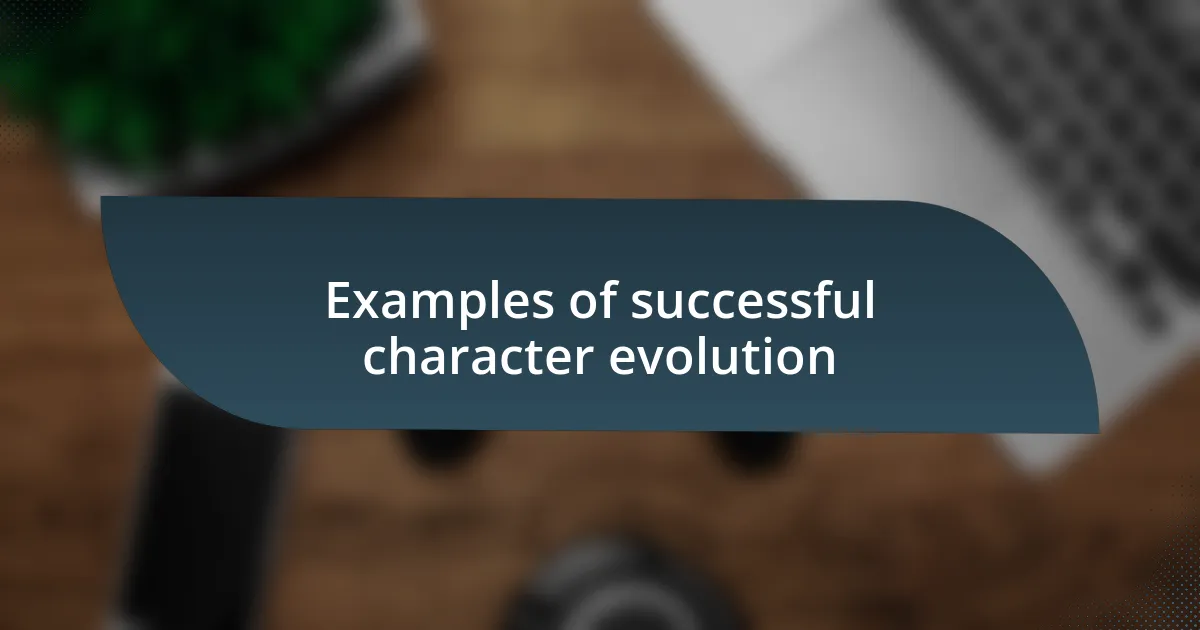
Examples of successful character evolution
Consider the evolution of Edward Elric from “Fullmetal Alchemist.” In the beginning, he is consumed by guilt and a desperate need for redemption. His journey not only showcases his growth into a more compassionate individual but also emphasizes the sacrifices made along the way. I often reflect on how his transformation mirrors the real struggles people face when seeking forgiveness or understanding.
Another excellent example is the character arc of Walter White in “Breaking Bad.” Walter starts as a meek high school chemistry teacher, morphing into a formidable figure in the drug world. Watching his moral descent raises the question: how far would you go for your ambitions? This transformation is powerful, as it allows viewers to explore the darker sides of human nature, making us question our own values and choices.
In the realm of classic literature, Elizabeth Bennet from “Pride and Prejudice” stands out for her character evolution. Initially, she’s quick to judge those around her, but as she interacts more deeply with Darcy, her perspectives shift dramatically. Her journey reminds me that personal growth often stems from challenging our own perceptions and biases. Don’t you find it intriguing how love can be a transformative force in character development?











